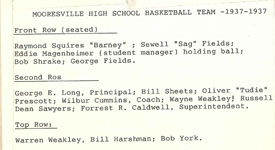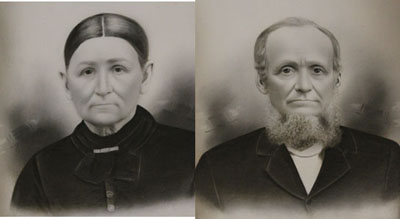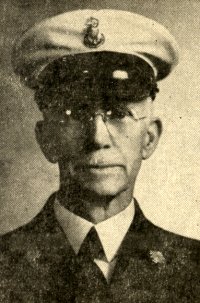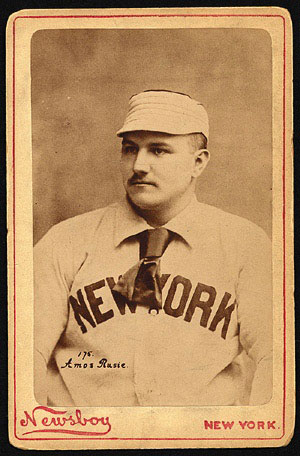
FAMOUS MOORESVILLIANSMooresville (Indiana) Public Library
ROBERT INDIANA
Famed artist Robert Indiana (1928-2018) (Robert Earl Clark) attended school in Mooresville when his family lived here in 1934-1935 (first on a farm, then in a house on Lockerbie Street). In 1935 Robert’s first grade teacher, Miss Ruth Coffman (later, Mrs. Maurice Haase) (1910-1995), recognized his artistic talents and encouraged Robert to pursue art as a career. (Learn more about Ruth Coffman Haase from a few items stored in the library’s Indiana Room “Robert Indiana” vertical file, as well as from this slideshow.)

Robert Indiana’s LOVE (1967)

Robert Indiana and feline friend in his New York studio (1965)


Signed Robert Indiana poster (1968) outside MPL Indiana Room
Can you find one of Robert’s sign creations hanging in the library? (Hint: You’ll see it near the MPL Indiana Room, which has several books about the artist.) Visit the Robert Indiana website for more fascinating details about his life and times. Click here to read a transcript of oral history interviews that the Smithsonian Archives of American Art recorded with the artist (Sept. 12-Nov. 7, 1963)–note especially pages 14-18, in which the artist discusses his time in Mooresville (although in the interviews he incorrectly recollects Miss Coffman’s name as Coffin, a Nantucket name mentioned in one of Robert’s favorite books, Moby Dick [1851], by Herman Melville). The library also has a 1968 poster designed and signed by the artist, which he presented to Ruth Coffman Haase, on display next to the media alcove (see photos above; to see enlargements of these images, read this blog post). Click below (right) to watch our video about Robert Indiana.

(Image courtesy of RobertIndiana.com)
Video (Right):
JOHN DILLINGER
Perhaps the most famous person to live in Mooresville was the bank robber John Dillinger (1903-1934). The library has several books about Dillinger in our Indiana Room collection, and a local history blog features a few articles about him. Watch the video (below, right) to learn about Dillinger’s holdup of grocery store owner Frank Morgan, which resulted in Dillinger’s first criminal conviction. This event occurred just one block from the Library! Read about it in the Mooresville Times (Sept.-Oct. 1924), including accounts of the trials of Dillinger and his accomplice, Edgar Singleton. Dillinger’s family maintained that it was Singleton who encouraged Dillinger to rob Morgan, after the elder Singleton plied the younger Dillinger with alcohol in a local pool hall. Dillinger received a much harsher sentence–unusually harsh for a first offense–than Singleton, presumably because of the battery upon Morgan (Dillinger hit Morgan in the head with a metal rod, and Dillinger’s gun discharged when it hit the ground as the two struggled). It was widely believed that, because of this harsh punishment, Dillinger became embittered and, while congregating with hardened criminals in prison, learned the skills he later used in his famous bank robberies. After FBI agents killed Dillinger in Chicago in July, 1934, he was taken to Harvey Funeral Home (then on the southeast corner of Indiana and Harrison Streets in downtown Mooresville), where his showing attracted people far and wide. Thousands endured the 103-degree F. heat to see Dillinger’s body. The line of onlookers wound around the block (twice). Watch our video (below, left) for details.
Researchers Jay Robert Nash and Ron Offen speculated that John Dillinger was not killed in 1934 but escaped to live in the American Southwest into the 1960s. (Click here to learn more.)
Before Dillinger became a criminal, he was a semi-professional baseball player who played second base and shortstop for the Mooresville Walkovers and the Martinsville Athletics. Watch our video (third one, below) to learn more about Dillinger and Mooresville/Martinsville baseball. The fourth video (below) shows where John Dillinger’s Mooresville home was located.
Click Videos to Play
PAUL HADLEY
Besides being an accomplished interior designer and artist (especially in watercolor, which he taught at John Herron Art Institute in Indianapolis), longtime Mooresville resident Paul Hadley (1880-1971) designed the Indiana State Flag (submitted, 1916; adopted, 1917 as the Indiana State Banner). The library has many of Hadley’s original paintings on display in the grand hall (see brochure #1 and brochure #2). The MPL Indiana Room also has many items in its collection about him (click here for a bibliography, biographical information, photos, and more). Read more about this quiet, fascinating gentleman (and his paintings) in our “treasure trove” blog, our Cauli Le Chat blog, and our “flash from your past” flashcard, as well as in his biography, The Indiana State Flag: Its Designer (Biography of Paul Hadley with Anthology of his Paintings), by Becky Hardin (1976) (PART ONE and PART TWO). There are also digital versions of biographical articles published in Traces and Indiana magazines (scroll down to see links). In 2017 the Indiana Historical Bureau published an excellent article about Hadley and the Indiana State Flag’s history.



Paul Hadley Biographical Videos
Click the videos below to learn more about Paul Hadley.
Paul Hadley Biographical Video, Part One
Paul Hadley Biographical Video, Part Two
Paul Hadley Biographical Video, Part Three
Paul Hadley Biographical Video, Part Four
Paul Hadley Biographical Video, Part Five
Celebrating Paul Hadley & the Indiana State Flag Centennial (April 16, 2016)
Watch our video (below) of a panel discussion (and Q & A session) about Paul Hadley and the Indiana State Flag (April 16, 2016).
Further Reading About Paul Hadley
- Baker, Marie Siebert. “How Indiana’s State Flag Was Developed.” Hoosier Farmer (July, 1983).
- Paul Hadley article (“Mooresville Claims Fame as Home of Indiana Flag,” Six County Topics: Star Courier Tribune, v. 1, #12, Wednesday, February 5, 1969).
- Paul Hadley bibliography
- Paul Hadley (blog posts)
- Paul Hadley illustrated letter to Fred R. Glidden, with original sketches (postmarked April 30, 1943).
- Paul Hadley paintings on display at MPL
- Paul Hadley photos (1885, 1888, ca. 1905) (donated by Sheila Jones of Yellow Moon Antique Mall)
- Hardin, Becky. The Indiana State Flag: Its Designer (Biography of Paul Hadley with Anthology of his Paintings) (1976).
- Perry, Rachel Berenson. “Paul Hadley: Artist and Designer of the Indiana Flag.” Traces of Indiana and Midwestern History 15:1 (Indiana Historical Society, Winter 2003): 20-29; “Paul Hadley, Indiana State Flag Designer.” Indiana Magazine (Indiana Dept. of Commerce, Nov. 1977): 24-25; MPL biographical handout.
- Poletika, Nicole. “‘A Permanent Emblem of Its Own:’ The Indiana State Flag & Its Designer.” Indiana Historical Bureau (blog), January 11, 2017.
- Representative David W. Evans (Indiana) spoke about Paul Hadley and Becky Hardin’s biography in The Congressional Record, April 14, 1976 (“Accomplishments of Citizens and Patriots“).
- The Indiana Senate passed a resolution honoring Paul Hadley following his death in 1971 (see copy).
AMOS RUSIE
Mooresville native Amos Wilson Rusie (1871-1942), “the Hoosier Thunderbolt,” pitched for the New York Giants between 1890-1901. He held many major league pitching records and was considered the fastest pitcher in professional baseball. For more about Rusie, watch the videos below; read this article from Traces of Indiana and Midwestern History (1989); take a look at our “flash from your past” flashcard; or visit the MPL Indiana Room, to learn more about this all-star pitcher.
TOP VIDEO: Amos Rusie: The Hoosier Thunderbolt, by Pete Cava
(MPL Program Video, April 2, 2016)
BOTTOM VIDEO: Amos Wilson Rusie, the Hoosier Thunderbolt (Mooresville Moments #20) (2020)
FRANK INN
Camby native Frank Inn (born Elias Franklin Freeman) (1916-2002) grew up on the Charles Mendenhall farm near Mooresville (the farm was in Guilford Township, Hendricks County). His parents operated E. A. Freeman Florist shop in Mooresville for many years. During the 1950s until circa 1964, the florist shop was located at 42, 46, 60 & 62 East Washington Street (customers and suppliers often used Lincoln Lane for pickups and deliveries). From circa 1964 through the early 1980s, the florist shop was situated at State Road 67 Bypass and South Park Drive.
Frank Inn was best known as an animal trainer for Hollywood movies (such as Benji, The Thin Man series, and Breakfast at Tiffany’s) and television programs (such as the 1960’s sitcoms The Beverly Hillbillies, Green Acres, and Petticoat Junction). For Green Acres, Inn trained Arnold the Pig (character name: Arnold Ziffel). Arnold came from Jim Clem’s farm on Johnson Road just outside Mooresville. Inn won 40 PATSY (Picture Animal Top Star of the Year) Awards for the animals he trained for movies and television. The International Association of Canine Professions (IACP) honored Inn as its first Hall of Fame inductee. (See Inn’s online biography.)


Inn’s book about Benji is available to check-out from our Evergreen Indiana catalog. Visit the MPL Indiana Room, or read this brief biography, to learn more about the man and his talented animals.
On May 7, 2016, the library presented a program celebrating the 100th anniversary of Frank Inn’s birth. We captured the program on video (below). Frank Inn was portrayed by David Reddick, chair of the Morgan County Indiana Bicentennial Celebration.
SAMMY LEE DAVIS
Sammy Lee Davis moved to Waverly, Indiana from California following his junior year to attend Mooresville High School (graduated MHS Class of 1966). After enlisting in the U.S. Army, he distinguished himself in combat service in Vietnam and, on November 19, 1968, was awarded the Congressional Medal of Honor by President Lyndon B. Johnson (see the Weekly Compilation of Presidential Documents, Monday, November 25, 1968, pp. 1611-12, 1614). Davis has an autobiography available to checkout from our Evergreen Indiana catalog.


JULIA D. NELSON

Julia D. Nelson, Indiana’s First Female State Legislator
(Mooresville Moments 26)
The first woman to serve in the Indiana General Assembly was Mooresville native Julia D. Nelson.
Born in Mooresville on December 11, 1863, Julietta (“Julia”) Reynolds attended the Mooresville Academy School until 1880, when she married Edward F. Nelson. The couple moved to Indianapolis circa 1887. Subsequently, in 1903 Julia and Edward moved to Muncie, Indiana, where Edward was employed as a pressman for the local newspaper. Julia served as chairwoman of the Delaware County Republican Women’s Club during the 1920 elections. She was also active in the women’s suffrage movement, as well as organizations such as the Order of the Eastern Star and the State Assembly Women’s Club.
Following the death of state representative J. Clark McKinley just before the November, 1920 election, Julia D. Nelson was selected as McKinley’s replacement to represent Delaware County in the Indiana House. Julia served one full term (1921-1923). Her first speech before the General Assembly called for legislation for the care and support of poor parents by their children. During her first year in office, she introduced five resolutions, of which the most notable were:
- House Bill 425: To establish private hearings in criminal cases involving rape and in determination of paternity hearings.
- House Bill 322: To establish an Indiana Motion Picture Board to examine, approve, and regulate movies shown in Indiana theaters.
In 1932, following Edward’s death, Julia moved back to Indianapolis. She died on May 27, 1936 and is buried in Crown Hill Cemetery.
Many thanks to the Indiana Commission for Women for information about Julia D. Nelson.
CLIFFORD C. FURNAS
Clifford C. Furnas (1900-1969) graduated from Mooresville High School in 1918. He earned his bachelor degree from Purdue University (1922), at which he excelled in track and field. He secured a position on the U.S. Olympic team and competed in the 5,000 meters event at the 1920 Olympic Games in Belgium. He earned his Ph.D. in chemical engineering from the University of Michigan (1926). From 1926-31 he worked as a physical chemist with the U.S. Bureau of Mines in Minneapolis. Thereafter, he became a professor of chemical engineering at Yale University.
In 1941, at a meeting of the American Chemical Society, Furnas caused a sensation when he recommended the development of solar power as an alternative energy resource to fossil fuels. During World War II, he directed the Curtiss-Wright airplane division. In 1954 Furnas became chancellor of the University of Buffalo. He served as an assistant secretary of defense in the Eisenhower administration (1955-57). In 1962, he guided the University of Buffalo’s transition into the State University of New York at Buffalo (SUNY-Buffalo), serving as its first president until his retirement in 1966. He published many noteworthy scholarly books and articles throughout his distinguished academic and professional career. Checkout a book describing his lifetime achievements from our Indiana Room collections. (To see an enlargement of the class photo below, read this blog post.)
GEORGE H. FIELDS
George H. Fields (1921-2014) was a life-long Mooresville resident who became Mooresville High School’s first Indiana boys’ basketball all-star and, later, he became a standout on Purdue University’s men’s basketball team. His parents were Herbert Andrew and Georgie (Conduitt) Fields. George passed on January 22, 2014. To see enlargements of George’s images below, read this blog post.





SAMUEL MOORE, FOUNDER OF MOORESVILLE
Mooresville, Indiana was founded in 1824 by Samuel Moore, whose Quaker family moved from North Carolina in 1818 to Washington County, Indiana, settling near the town of Salem. The Moore family found slavery inconsistent with their religious beliefs and moved north to escape the practice. Samuel moved away from his family and settled in Brown Township, Morgan County, Indiana, in 1822.
Samuel Moore was not the first European-descended settler to homestead in Morgan County or Brown Township. Jacob Wetzel became the first white settler in Morgan County (1818), and William Ballard settled in Brown Township in 1820. Moore established the first trading post in Brown Township in 1822. It was situated atop a hill approximately where today’s V.F.W. Post #1111 now stands on South Indiana Street, a few hundred feet east of White Lick Creek. Moore made no distinctions based on color, race, or national creed; he traded with Native and European-descended Americans alike. Customers paid for his goods in silver, as well as barter items (primarily deer and raccoon skins, ginseng, bees wax, and buck horn).
As his business flourished, in 1823 Samuel Moore purchased 20 acres of land (at $2 per acre) atop a hill east of White Lick Creek and about a half-mile north of his trading post. He platted the town in 1824, which consisted of four five-acre blocks, with each block containing 16 lots (see the original plat below; click-on the image to enlarge it). The plat was recorded on Feb. 21, 1825. The town, however, dates its origin to 1824, and this is the historically accepted date.
To see enlargements of the images below, read this blog post.


In 1924, to celebrate the town’s centennial, a historical marker commemorating Samuel Moore’s founding of Mooresville was placed on the northeast corner of Main and Indiana Streets downtown at the site where Moore’s wood-frame general store was built a century before (it was the first wood-frame business in town). The marker consisted of a stone and plaque, which were removed in summer 2017 during renovations to Paul Hadley mini-park (renamed Bicentennial Park). The “founder stone” has been returned to its original position.
Asa Bales constructed the first cabin in Mooresville, and the first wood-frame business structure was built by Samuel Moore on the northeast corner of the intersection of Main and Indiana Streets. Moore conducted business there for 44 years. His goods travelled by wagon and boat across southern Indiana and even as far away as Boston and New Orleans.
In 1828, Samuel Moore married Eliza Worthington, who later founded the Methodist Episcopal (M.E.) Church in Mooresville. (Click here to see photos of the couple in their golden years.)
Eliza Moore passed over on December 10, 1873, and Samuel Moore joined her on March 1, 1889. We have the original copy of Samuel Moore’s last will and testament, executed July 21, 1888, and filed for probate in Morgan County Circuit Court on March 15, 1889. For “moore” information about Samuel & Eliza (and town history generally), see this handout and another handout. For a brief “family tree” of Samuel & Eliza and their descendants, click here. This handout explores the various homes in which Samuel & Eliza (and their family) lived in Mooresville.
“Narration” of Samuel Moore at the Old Settlers Picnic (1885)
(Dramatic Reenactment)
REV. DR. FRANK CLAUDE HUSTON


The Reverend Dr. Frank Claude Huston (1871-1959) was pastor of Mooresville First Christian Church (Disciples of Christ) (1934-1937). He was an internationally renowned composer and singer who wrote and performed hymns, gospel music, ballads, popular songs, patriotic tunes, and dance songs. (Click here, here, and here to learn more.) Dr. Huston founded his own music publishing companies in Indianapolis and New York. He composed a tribute song, “Mooresville” (1935), which proclaimed the townspeople’s virtues and praised its hometown values. (Click here to see a copy of Huston’s original music score for the town’s song.) The library has several copies of the history of Mooresville First Christian Church (Disciples of Christ) available to check-out from our Evergreen Indiana online catalog. Click below to watch our video about Rev. Dr. Huston.
Rev. Dr. Frank C. Huston (Mooresville Moments 8),
by Mooresville Public Library
RUTH ELLEN COMER



Ruth Ellen Comer (1909-1995) was the daughter of Charles Benton Comer and Mary Aldrich Comer. She graduated from Mooresville High School and Butler University School of Music and further studied music at the University of Southern California. She was a professional musician, playing piano, pipe organ, and accordion. She was best known as a member of the musical group, Maria Karson & Her Musicales (1940s), who appeared on national radio and played a variety of clubs and hotels across the country. Click here to learn more about this gifted lady, or watch our video (below).
LEON ADLER

Leon Adler, Mooresville’s Movie Mogul (Mooresville Moments 18)
by Mooresville Public Library
The National Motion Pictures Company specialized in educational and industrial films. One offering was the 1939 short film, Told By a Tooth, which promoted dental hygiene. The movie is available to watch from the Prelinger Archives. Adler used Mooresville talent and locations to appear in his movies, and he also used famous Hollywood personnel, such as Academy Award-winning cinematographer Floyd Crosby.
BOBBY HELMS
Bobby Helms (Robert Lee Helms) (1933-1997)–perhaps best known for the songs “Fraulien” (1957), “Jingle Bell Rock” (1957), and “My Special Angel” (1957)–was born in Bloomington, but, in later years, was a resident of Martinsville (he’s buried there in Hilldale cemetery). He is a member of the Morgan County Hall of Fame. His Mooresville connection comes from the 1970s, when he owned a restaurant/nightclub, the Special Angel Club, which was situated at Five Points (between Mooresville and Waverly), where State Road 144, Kitchen Road, and Orchard Road converge. Learn more about Helms from this official Facebook page.



ARTHUR C. NEWBY
Arthur C. Newby (1865-1933) was born and raised near Monrovia, Indiana, but owned land in Mooresville that became an important part of local education here (see below, and watch this video). Newby was an early bicycle and automobile manufacturer and co-founded the Indianapolis Motor Speedway. He moved to Indianapolis in 1881 seeking employment and was a middle manager for the firm of Nordyke & Marmon. In the 1890s, Newby co-founded the Zig-Zag Cycling Club, and, along with Charles E. Test and Edward Fletcher, he established the Indianapolis Chain & Stamping Company, which later became the Diamond Chain Company. By the end of the 1890s, Newby’s business was supplying roughly 60 percent of American-made bicycle chains. From 1894 to 1899, Newby was also associated with Hay & Willits Manufacturing Company, which made Outing bicycles, a popular brand.


Arthur C. Newby, Mooresville’s Quiet Philanthropist
by Mooresville Public Library
(Mooresville Moments 19)
In 1898 Newby teamed with James A. Allison and Carl G. Fisher to construct the Newby Oval, a bicycle racing track near 30th Street and Central Avenue in Indianapolis. This trio later founded the Indianapolis Motor Speedway in 1909. By the turn of the 20th century, Newby focused upon automobile manufacture, co-founding the National Motor Vehicle Company, which built electric and gasoline-powered automobiles.
“In 1920, Arthur C. Newby gave a 140 acre farm (located west of Mooresville near Bingham and Greencastle Roads), together with considerable other property, to the Mooresville School Association. His wishes were that they be sold and proceeds used toward the creation of a new school with the stipulation that it be named in memory of his uncles, William and Milton Newby. Mooresville’s existing elementary school, the Academy Building which originally housed MHS [Mooresville High School], was filling more and more each year. The William and Milton Newby Memorial Elementary School was decided upon and plans were drawn in 1935. Construction began in January 1936. The cost was approximately $93,000. The architectural style was Georgian Colonial. The new building included ten classrooms, a recreation room, cafeteria and kitchen, four dressing rooms, the principal’s office, a suite for first aid, music and art supervisor’s office, teachers’ rest rooms, a workshop for the custodians and a large storage room were also included in the plan. The school grounds covered about eight acres of picturesque rolling and wooded lot.” [Quoted from Susan Haynes (2016). William and Milton Newby Memorial Elementary School. Mooresville, Indiana: Mooresville Consolidated School Corporation.]
JAMES WHITCOMB RILEY

Although famous Hoosier poet James Whitcomb Riley (1849-1916) grew up in Greenfield, Indiana, in Spring 1874 he moved to Mooresville to live with his aunt and uncle, Jim and Ann Marine, while he worked as a sign painter in a shop located at 25 South Indiana Street downtown. The building is known as the Perce Building (for owner Dr. B. H. Perce, who had it constructed around 1865). Our video (below), this slideshow, and this blog post, elaborate.
In addition to sign painting, Riley wrote articles and humorous quips for the local newspaper, the Mooresville Enterprise, as well as for other Morgan County newspapers. When trade was slack, Riley would slip around the block to hang out with local photographer and Civil War veteran Jarvis P. Calvert at his art and photographer studio on East Harrison Street.

CLIFTON WHEELER



Clifton Wheeler (1883-1953) was born in Hadley, Hendricks County, Indiana, in 1883. While in the fourth grade, his family moved to Mooresville when his father, Alonzo L. Wheeler, purchased the Banner Flour Mill on East High Street (at the railroad tracks, where the car wash is located today). The Wheeler family lived in the house on the southwest corner of the intersection of Indiana and High Streets.




In a letter (1945) to the Art Museum of Greater Lafayette (Indiana), Clifton Wheeler wrote, “When I finished high school I was reluctantly allowed to come to Indianapolis to William Forsyth’s studio for a year. Forsyth and my doctor aunt, who lived in New York, assured my parents that I would not necessarily be a tramp if I studied art and at last they sadly agreed that I might go to New York for a year to art school.”
The ArtSmart Indiana website states, “Wheeler had studied under Forsyth at the Herron Art Institute. He then studied with William Merritt Chase in New York City and went to Europe twice to study. Around 1911 he returned to Indiana with his wife, and they built a home and studio in Irvington, an eastside Indianapolis neighborhood where Forsyth and other artists also lived. He became an instructor at the Herron Art Institute, in charge of the antique class. . . . Wheeler had no special technique or subject, but his decorative work was well known, and he had murals all over the country. His murals at the Indianapolis Circle Theatre and City Hospital ([later] Wishard) are among his best work. His landscape paintings—especially his snow scenes—are held in high regard.”
Paul Hadley, another Mooresville artist (see above) who also taught at Herron Art Institute, considered Clifton Wheeler to be the best of the Hoosier Group school of artists.
To see more Clifton Wheeler paintings and drawings, visit the ArtSmart Indiana website or see these search results.
Looking for "Moore" Local History?
Explore the local history of Mooresville, Indiana and vicinity by clicking the treasure trove blog logo.







